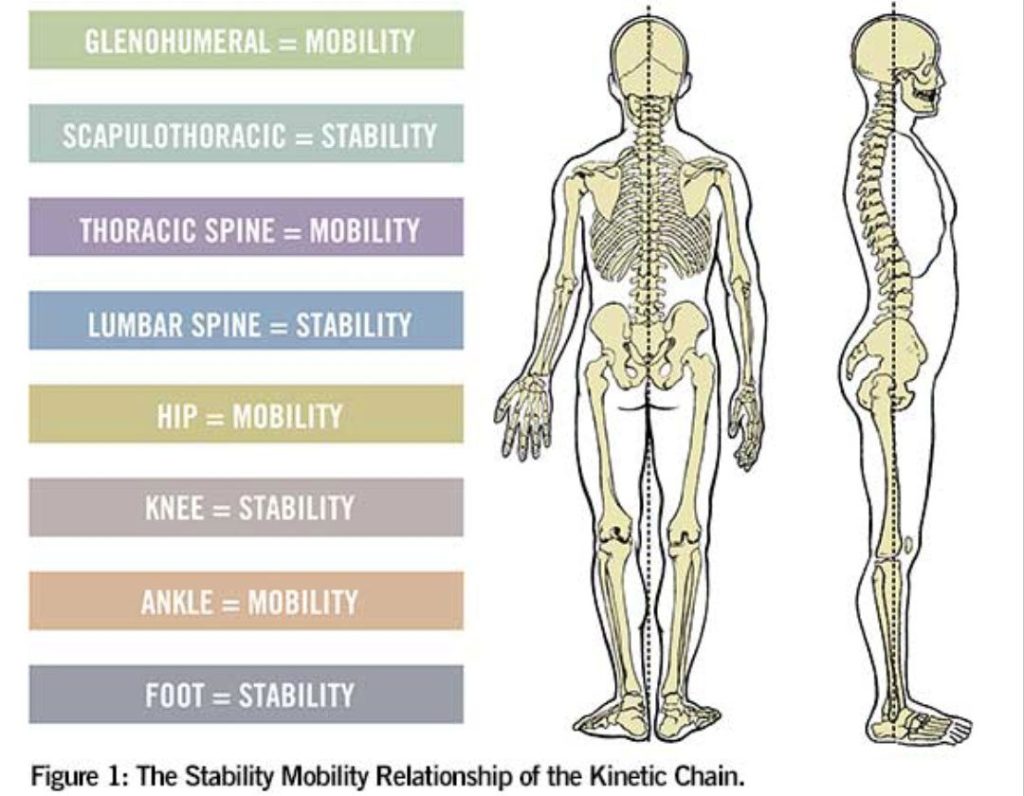Musculoskeletal injuries from trauma, repeated activities, or overused joints or muscles are very common — in fact, almost every one of us will get injured at some point in our lives. Most of the time, it will reoccur and become more serious when left unattended or untreated. When repeated injuries happen, it is very likely not due to a one-off fluke.
So why do we constantly get hurt at a specific joint or muscle? And why does the pain seem to travel elsewhere after?
The human body is complex and designed to move in countless movement patterns. When we move, kinetic energy travels from our feet to our neck and head. This concept is called the Human Body Kinetic Chain Movement. Our skeletal system consists of various joints linked in a chain, each with specific purpose and function.
Stability and Mobility at the Joints

When our joint is not functioning as it is intended to, our body will adopt a dysfunctional movement, which can lead to acute pain in our joints or muscles. If not corrected, chronic pain can happen. A sedentary lifestyle, past injuries, poor posture and misalignment, stress, health conditions, diseases, and other factors can lead to the development of dysfunctional movement.
Here’s an example of a common dysfunctional movement at the lower proximity. If your ankle (which is supposed to be mobile) is stiff, your body will seek mobility at the knee which is supposed to act as a stable hinge. A painful knee typically develops as a result. In another scenario, if you spend extended periods of time sitting and experience restricted mobility at your hips, your body may compensate by seeking mobility at your knee or lumbar spine. This reversal of joint roles can lead to injury or pain in the affected joint or muscle.
Continuing to compensate for the long term can cause a cascading effect such as muscle imbalances, poor neuromuscular function and muscle atrophy or hypertonicity.
One of the common mistakes we make is to only address the symptom (pain) with the use of NSAIDs, massage, chiropractic therapy and other non-invasive or invasive treatments, rather than addressing the underlying cause of the problem.
Another widespread misunderstanding is the idea that simply strengthening the muscle at a joint can solve the problem, without considering its kinetic chain relationship. For example, strengthening the quadriceps to alleviate knee pain, without taking into account the mobility of the ankles and hips or the stability of the lumbopelvic area.
That’s why it’s crucial to have a comprehensive understanding of how our bodies are designed to move, and to identify any weak links in our body’s kinetic chain to ensure optimal recovery through appropriate rehabilitation measures, and not view the problem in isolation.
Typically, it is advisable to conduct an assessment initially to pinpoint the root of the problem. However, when a patient presents to my clinic in pain, they often exhibit compensatory movement patterns that can yield false positives/negatives results. For this reason, my approach is to first identify the type of pain or injury they are experiencing and address their pain as a priority. To reduce their pain levels, I utilize methods such as soft tissue manipulation and other therapies that are appropriate for their condition.

Soft tissue manipulation and manual therapy, such as massage has been proven to:
- alter pain signal at the central nervous system,
- manage inflammation,
- inhibit muscle spasm and reduce muscle tonicity,
- improve blood circulation and oxygenation to the injured tissue,
- and improve mobility and flexibility at the joint.
It is best to engage a practitioner who is trained or skilled in this field, or perform self myofascial massage by using a foam roller or trigger point massage ball under guidance.
Once the pain has been adequately managed, I will proceed with a thorough assessment to identify any potential weak links in the person’s kinetic chain. After that, they will begin an active treatment program that includes targeted stretches, mobility drills, and muscle reactivation exercises through a set of neuromuscular exercises. The rehabilitation program also emphasizes teaching the person to disassociate their movements and joints through specific exercise drills, which re-trains their brain to use their muscles and joints as it is supposed to. As soon as they are able to correct their dysfunctional movement, it is highly recommended to strengthen the entire structure based on function, rather than relying solely on brute strength.
Understanding the concept of our body’s biomechanics and how kinetic chain work can help you better manage or even resolve musculoskeletal injuries holistically, and not just detaching the problem to a specific joint or muscle.
Do take note that different types of musculoskeletal injuries may require different forms of therapy or approach. It is extremely important to seek a professional’s help to determine the appropriate care for your musculoskeletal pain or injury.
Ke Wynn Lee is an author and an international award-winning corrective exercise specialist currently owns and operates a private Medical Fitness Center in Penang. Apart from coaching, he also conducts workshops and actively contributes articles related to corrective exercise, fitness & health to online media and local magazines.
References
Field, T. (2014). Massage therapy research review. Complementary Therapies in Clinical Practice.
Moyer, C. A., Rounds, J., & Hannum, J. W. (2004). A meta-analysis of massage therapy research. Psychological Bulletin.
Crane, J. D., Ogborn, D. I., Cupido, C., Melov, S., Hubbard, A., Bourgeois, J. M., & Tarnopolsky, M. A. (2012). Massage therapy attenuates inflammatory signaling after exercise-induced muscle damage. Science Translational Medicine.
American Council of Exercise (ACE)
National Academy of Sports Medicine (NASM)

